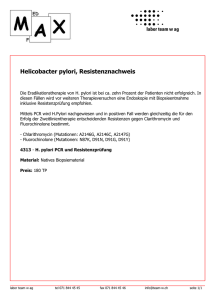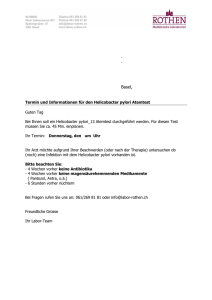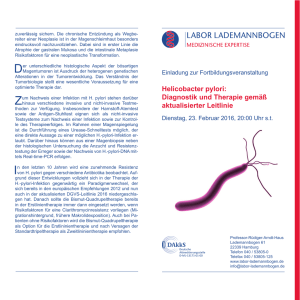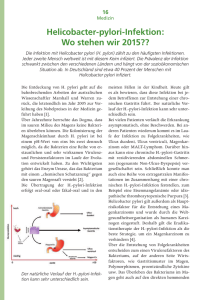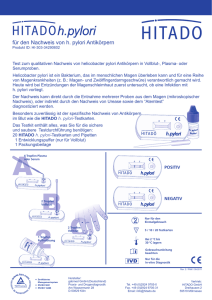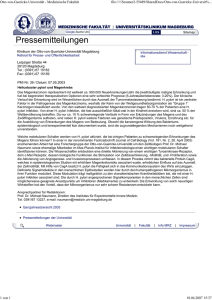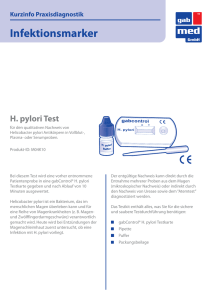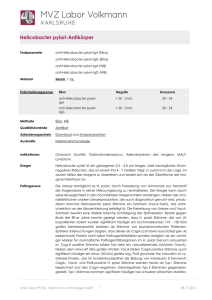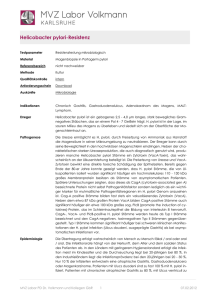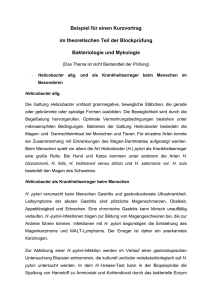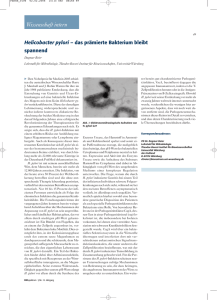H. pylori Infektion- Leitlinien Was ist neu?
Werbung
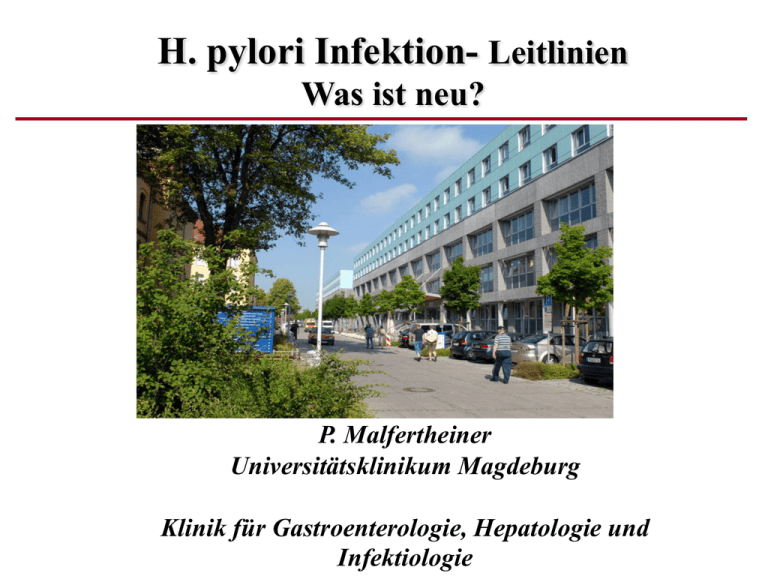
H. pylori Infektion- Leitlinien Was ist neu? P. Malfertheiner Universitätsklinikum Magdeburg Klinik für Gastroenterologie, Hepatologie und Infektiologie TheIcemanhadahighlyvirulentstrain anddetectableinfalammatoryreactioninthestomach Science. 2016 Jan 8;351(6269):162-5 TheIcemanhadahighlyvirulentstrain anddetectableinfalammatoryreactioninthestomach Science. 2016 Jan 8;351(6269):162-5 Epidemiologie Statement 1.2 Die Prävalenz der H. pylori-Infektion in Deutschland liegt zwischen 3 % (Kinder) und 48 % (Erwachsene). Sie ist deutlich höher bei Immigranten (36 – 86 %). Konsensusstärke: starker Konsens Fischbach et al. Z Gastroenterol 2016:54;327-363 Empfehlung/Statement 1.4 Der enge Kontakt von Kindern mit H. pyloriinfizierten Familienangehörigen stellt den wichtigsten Übertragungsweg dar. Konsensusstärke: starker Konsens Fischbach et al. Z Gastroenterol 2016:54327-363 Z Gastroenterol 2016:54;327-363 DGVS Statement 3.11 Vor einer geplanten Dauermedikation mit niedrig dosiertem ASS sollen Patienten mit einer Ulkusanamnese auf eine H. pylori-Infektion untersucht und bei Keimnachweis einer Eradikationstherapie zugeführt werden. Konsensusstärke: starker Konsens – starke Empfehlung Fischbach et al. Z Gastroenterol 2016:54327-363 Indikationen zur H.-pylori-Eradikation DGVS Leitlinien 2016 Starke Empfehlung Empfehlung Empfehlung offen Keine Empfehlung soll sollte kann Nein Peptisches Ulkus X MALT-Lymphom des Magens X Diffuses großzelliges B-Zell-Lymphom des Magens X Funktionelle Dyspepsie (Reizmagen) X Test-and-treat Idiopathische thrombozytopenische Purpura (ITP) X X Morbus Menetrier X Lymphozytäre Gastritis X Ungeklärte (nach adäquater Abklärung) Eisenmangelanämie X Vor ASS-Dauermedikation (bei Ulkusanamnese) X Obere gastrointestinale Blutung unter ASS X Vor NSAR-Dauermedikation (bei Ulkusanamnese) X Obere gastrointestinale Blutung unter NSAR X (plus PPI bei NSAR) Magenkarzinomprophylaxe (bei Risikopersonen) Asymptomatische Gastritis X X Empfehlung/Statement 3.5 Eine nicht invasive Testung auf H. pylori mit nachfolgender Eradikationsbehandlung für Deutschland nicht allgemein empfohlen. Konsensusstärke: mehrheitliche Zustimmung – Empfehlung offen Fischbach et al. Z Gastroenterol 2016:54327-363 Therapieentscheidung zur H. pylori Eradikation DGVS → 2 positive Testergebnisse (außer bei: Ulcus duodeni, positiver Kultur, Histologie) Maastricht V/Florenz → 1 positives Testergebnis Wo und wie viele Biopsien sollten entnommen werden? 4 Biopsien DGVS Leitlinie 2016 5 Biopsien Maastricht V / Florenz 2016 Beurteilungsparameter: Ø H. pylori Nachweis Ø Gastritis - Aktivität - Chronizität - Atrophie / Intestinale Metaplasie Die Diagnose Gastritis basiert Male, 73 y auf dem histologischen Befund 2 Biopsien 1 Angulus Female, 64 y 2 Biopsien Gastritis Staging OLGA OLGIM Wir müssen die Gastritis charakterisieren und das Risiko für mögliche Komplikationen abschätzen Gastritis Grading: OLGA Staging Benign Conditions Clustered in stages 0-II Neoplastic Lesions clustered in stages III-IV M. Rugge, Gastritis staging in clinical practice: the Olga staging system Gut. 2007 Updated Sydney system scores for atrophy and intestinal metaplasia in the angulus compared with antrum in the overall study population. Ang, angulus; ant, antrum; IM, intestinal metaplasia. Varbanova et al. J Clin Pathol. 2016 Jan;69(1):19-25. Mit NBI,FICE,BLI bei der Gastritis Diagnostik umdenken? BLI Antrum Antrum- Corpus Transitionsmukosa Corpus BlueLaserImaging(BLI)ofthegastricmucosa Indikationen zur H.-pylori-Eradikation DGVS Leitlinien 2016 Starke Empfehlung Empfehlung Empfehlung offen Keine Empfehlung soll sollte kann Nein Peptisches Ulkus X MALT-Lymphom des Magens X Diffuses großzelliges B-Zell-Lymphom des Magens X Funktionelle Dyspepsie (Reizmagen) X Test-and-treat Idiopathische thrombozytopenische Purpura (ITP) X X Morbus Menetrier X Lymphozytäre Gastritis X Ungeklärte (nach adäquater Abklärung) Eisenmangelanämie X Vor ASS-Dauermedikation (bei Ulkusanamnese) X Obere gastrointestinale Blutung unter ASS X Vor NSAR-Dauermedikation (bei Ulkusanamnese) X Obere gastrointestinale Blutung unter NSAR X (plus PPI bei NSAR) Magenkarzinomprophylaxe (bei Risikopersonen) Asymptomatische Gastritis X X Kyoto Global Consensus Report GUT 2015 Gut2015;64:1353 Key messages -H. pylori- Gastritis is an infectious disease -H.pylori gastritis specific entity of dyspepsia -High definition endoscopy with virtual chromoendoscopy to be implemented -H.pylori eradication before the development of preneoplastic lesions AlgorithmofdiagnosingH.pylori-associateddyspepsia HPpositivedyspepsiaafter investigation(EGD) Eradication Therapy Improved Symptom SustainedRelief (after6~12months) Nosymptomatic response Symptomrecurrence HP-associated dyspepsia Functional dyspepsia SuganoetalGut2015 Update on H.pylori managment Maastricht V/ Florence Gut 2017, Jan Maastricht V-Florence 2016 Statement H. pylori gastritis is a distinct entity and causes dyspeptic symptoms in some patients. H. pylori eradication produces long-term relief of dyspepsia in about 10% of patients ( = 10 %more than with any comparator drug). Level of Evidence: 1A (high) Agree Grade of Recommendation: strong 95% 39 Rather agree 2% 1 Indecisive 0% 0 Rather disagree 0% 0 Disagree 2% 1 MaastrichtV – Florence 2015 Statement 2 A test-and-treat strategy is appropriate for uninvestigated dyspepsia. This approach is subject to regional H. pylori prevalence and cost-benefit considerations. It is not applicable to patients with alarm symptoms or older patients Level of Evidence: 1A (high) Agree Grade of Recommendation: A (high) 95% 38 Rather agree 2% 1 Indecisive 0% 0 Rather disagree 2% 1 Disagree 0% 0 H.pylori gastritis Specific entity of Dyspepsia But > 80 % remain asymptomatic! Indikationen zur H.-pylori-Eradikation DGVS Leitlinien 2016 Starke Empfehlung Empfehlung Empfehlung offen Keine Empfehlung soll sollte kann Nein Peptisches Ulkus X MALT-Lymphom des Magens X Diffuses großzelliges B-Zell-Lymphom des Magens X Funktionelle Dyspepsie (Reizmagen) X Test-and-treat Idiopathische thrombozytopenische Purpura (ITP) X X Morbus Menetrier X Lymphozytäre Gastritis X Ungeklärte (nach adäquater Abklärung) Eisenmangelanämie X Vor ASS-Dauermedikation (bei Ulkusanamnese) X Obere gastrointestinale Blutung unter ASS X Vor NSAR-Dauermedikation (bei Ulkusanamnese) X Obere gastrointestinale Blutung unter NSAR X (plus PPI bei NSAR) Magenkarzinomprophylaxe (bei Risikopersonen) Asymptomatische Gastritis X X Empfehlung/Statement 4.4 Patienten mit asymptomatischer H. pylori-Gastritis sollte eine Eradikationsbehandlung angeboten werden. Konsensusstärke: starker Konsens – Empfehlung Fischbach et al. Z Gastroenterol 2016:54;327-363 DGVS Empfehlung/Statement 4.4 Patienten mit asymptomatischer H. pylori-Gastritis sollte eine Eradikationsbehandlung angeboten werden. Konsensusstärke: starker Konsens Fischbach et al. Z Gastroenterol 2016:54 327-363 Maastricht V- Florence I Indications/Associations Which are the clinical scenarios requiring treatment beyond established indications in the previous Maastricht consensus report? II Diagnosis Where is the progress in diagnostic methods/tests? III Treatment What is new? How to overcome resistance? IV Prevention/Public Health Should general H. pylori testing and treating become integrated in general medical strategy? V H. pylori, other Helicobacter, relationship with gut microbiota H. pylori and impact on gut microbiota,role of probiotics H.pyloriInfektion undMagenkarzinom Die „Challenge“ Ruskone´-Fourmestraux Gut 2011;60:747-758- H. pylori and gastric carcinogenesis Bacterial virulence factors Environmental Host factors Tobacco Cag A-EPYA Diet Vac Aallelotypes Polymorphisms of inflammatory cytokines Correa-Kaskade – Magenkarzinogese beim intestinalen Typ H.pylori Infektion Normales Gewebe Chronische aktive Gastritis Atrophische Gastritis Intestinale Metaplasie Dysplasie Mod. Correa, Cancer Research 1992 Malfertheiner et al. Nat Rev Gastroenterol Hepat 2014 Magenkarzinom Gastriccancerprevention ALarge-scalePopulation-basedTrialinChina Subjects (Age: 25-58) enrolled (N=184,786) 13C-UBT H. pylori (+) (N=105,973) Missing (N=816) Withdrawal (N=1,346) Eradication Completed (N=94,101) Exclusion (N=10,526) High dose group* (N=44,345) Low dose group# (N=43,930) H. pylori eradicated (N=32, 336) H. pylori eradicated (N=6, 614) H. pylori (-) (N=77,987) Excluded (N=5,826) LinquCounty F/U:7years *10dayQuadruple #10dayPPI;Bismuth PanKetal.Gut.2015May18.pii:gutjnl-2015-309197.doi:10.1136/gutjnl-2015-309197.[Epubaheadofprint] Pan K-Feng and Lian Zhang et al. Gut 2015;0:1–10. Ø A total of 184 786 residents aged trial and received 13C-urea breath test. 25–54 years were enrolled in this Ø H. pylori positive participants were assigned into two groups, either receiving a 10-day quadruple anti- H. pylori treatment or look-alike placebos together with a single dosage of omeprazole and bismuth. Ø H.pylori prevalence.was 57.6%. Ø A total of 94 101 subjects completed the treatment. Ø The overall H. pylori eradication rate was 72.9% in the active group. Screen and treat in low risk countries? Risiko für Entwicklung eines Magenkarzinoms innerhalb von 20 Jahren „niedrig Risikoland“ 405.172 Patienten mit Biopsie 1599 Patienten mit Magenkarzinom bei normaler Mukosa - Gastritis - atrophische Gastritis - intestinale Metaplasie - Dysplasie 1: 256 1: 85 1: 50 1: 39 1: 19 Song et al. BMJ. 2015 Jul 27;351:h3867 H.pylorigastritisdefinedasaprecancerouslesion Early Precancerous Lesions Gastritis Stage* O Stage* I Stage* II Stage* III Stage* IV Advanced Precancerous Lesions Intra-epithelial Neoplasia (IEN)# RuggeMetal. IEN Low Grade IEN High Grade Gut. 2016 Feb 29. pii: gutjnl-2015-310846 Inzidenz Magenkrebs nach Bundesländern Krebs in Deutschland 2009/ 2013 RKI 9. Ausgabe Gastric cancer 5-year age-standardised survival Stomach cancer European mean 25·1 (24·8–25·4) Northern Europe 21·9 (21·2–22·6) Denmark 16·0 (14·7–17·4) Iceland 34·5 (27·8–41·3) UK and Ireland 17·2 (16·8–17·5) Central Europe 28·1 (27·6–28·5) Austria 31·0 (29·9–32·2) Germany 31·3 (30·6–32·0) Netherlands 20·4 (19·7–21·2) De Angelis et al. Lancet Oncol. 2014 Jan;15(1):23-34 Was machen wir dagegen? Serologische Risiko-Evaluation Yoshida et al. Int J Canc 2013 Gut. 2016 ,Apr (4),563-74 Screening the general population at age 50 years reduced the lifetime intestinal-type NCGA risk (0.24%) by 26.4% with serum pepsinogen screening, 21.2% with endoscopy and EMR only 0.2% with H. pylori screening/treatment Serum pepsinogen screening was more effective and more costeffective than all other strategies, although its ICER varied from $76 000/QALY (current smokers) to $105 400/QALY (general population) Gastric cancer disease of the aged ICD-10 C16, Deutschland, 2007 – 2008 je 100.000 The late onset offers chance for prevention Krebs in Deutschland 2007/2008, 8. Ausgabe 2012 Screening auf „Präneoplasie“ des Magens Gastrin 17 Pepsinogen I + II PI/II-Ratio + „Gastropanel“ H.pylori-AK H.pylori Screen and Treat in conjunction with Colorectal cancer screening Colonoscopy plus H.pylori serology plus pepsinogen H. pylori positive 13C UBT/ or FAT* H. pylori negative H. pylori positive and/or Pepsinogen low Gastroduodenoscopy confirmation TREAT TREAT * FAT = Fecal Antigen Test Helicobacter pylori as risk factor for colonic neoplasms in 2013 and 2014 Colonic neoplasm OR Reference Hyperplastic polyps: (OR=1.24, 95% CI: 1.18–1.30) Sonnenberg and Genta [46] Adenomatous polyps: (OR=1.52, 95% CI: 1.46–1.57) Advanced adenomas: (OR=1.80, 95% CI: 1.69–1.92) Adenomas high-grade dysplasia: (OR=1.97, 95% CI: 1.82–2.14) Adenocarcinoma: (OR=2.35, 95% CI: 1.98–2.80) Colonic neoplasm overall: (OR=2.73, 95% CI: 1.76–4.24) Hyperplastic polyps: (OR=2.66, 95% CI: 1.23–5.74) Low-grade IEN polyp: (OR=1.85, 95% CI: 1.14–2.99) Colonic polyps: (OR=1.5, 95% CI: 1.26–1.79) Colon cancer: (OR=1.3, 95% CI: 1.07–1.59) Selgrad et al. [45] Rokkas et al. [44&] CI,confidenceinterval;IEN,intraepithelialneoplasia;OR,oddsratio. Malfertheiner and Selgrad Curr Opin Gastroenterol. 2014 Nov;30(6):589-95 Timeline Key developments in Helicobacter pylori clinical research First randomized controlled trial of H. pylori eradication for gastric cancer prevention Maastricht II Consensus Report Bismuth quadruple therapy revisited Nonbismuth quadruple therapies Maastricht IV/Florence Consensus Report Relationship between H. pylori and other extragastric diseases revealed 2000 2001 New quadruple therapies: § Sequential § Concomitant Many other Helicobacter species discovered Maastricht III Consensus Report 2004 Observational trial: H. pylori eradication prevents gastric cancer 2005 2008 Start of vaccine trials in humans Nobel prize for Marshall and Warren Probiotics proposed as an adjunct therapy in H. pylori eradication 2010 2012 Screen and treat strategies might be most effective approach in gastric cancer prevention Is mass eradication the way to go? MAPS atrophic gastritis surveillance Malfertheiner P. et al. Nat. Rev. Gastroenterol. Hepatol. 2014, vol 11,no10,628-638 Kyoto global consensus on gastritis 2015 2013 2014 Screen and treat strategies Maastricht V Florence Consensus Report 2016 H. pylori Infektion Therapie erfolgt Resistenz- adaptiert Ø bacterial antibiotic resistance is regionally variable Øclarithromycin resistance has been rapidly increasing in many countries over the past decade, with rates as high as approximately 30% in Japan and Italy, 50% in China and 40% in Turkey; Ø resistance rates are much lower in Sweden and Taiwan, at approximately 15%; there are limited data in the USA. Other antibiotics show similar trends, although less pronounced. Aliment Pharmacol Ther. 2016 Feb;43(4):514-33. DGVS Leitlinien 2016 Therapiealgorithmus zur H.-pylori-Eradikation Wahrscheinlichkeit für Clarithromycinresistenz Wahrscheinlichkeit für Clarithromycinresistenz niedrig hoch PPI + CLA + Amoxi oder MET oder Bismut-Quadrupeltherapie Bismut-Quadrupeltherapie oder konkomitierende Vierfachtherapie Therapieversagen Therapieversagen Bismut-Quadrupeltherapie oder fluorochinolonhaltige Tripeltherapie fluorochinolonhaltige Tripeltherapie Therapieversagen Therapieversagen Resistenztestung DGVS Empfehlung/Statement 5.12 Bei niedriger Wahrscheinlichkeit für eine primäre Clarithromycin-Resistenz können in der Erstlinientherapie eine Standard-Triple-Therapie oder eine Bismuth-basierte Quadrupeltherapie eingesetzt werden. Konsensusstärke: starker Konsens – Empfehlung offen ALGORITHM FOR FIRST-LINE TREATMENT Low (<15%) clarithromycin resistance Standardtriple (PPI-amoxicillin-clarithromycin) orbismuthquadruple High (>15%) clarithromycin resistance Low (<15%) metronidazol e resistance Low dual (<15%) clarithromycin and metronidazole resistance High dual (>15%) clarithromycin and metronidazole resistance PPI-amoxicillinmetronidazole triple Non-bismuthquadruple concomitant orbismuthquadruple Bismuth quadruple Minimal 10-14 days ALGORITHM FOR SECOND-LINE TREATMENT (empirically) Failure of PPIamoxicillinclarithomycin Fluoroquinolone triple/quadruple or bismuthquadruple Failure of bismuth quadruple Fluoroquinolone triple/quadruple Failure of non-bismuth quadruple Fluoroquinolone triple/quadruple or bismuthquadruple Yearly percentages of quinolone and triple resistance and their dependence on prior eradication treatments. 18,7% Wueppenhorst et al. J Antimicrob Chemother 2013; 68: 1562–1566 Helicobacter 2016 Feb;21(1)29-34 Ø Three hundred consecutive HP-infected patients received antimicrobial susceptibility-guided therapy or empirical concomitant therapy for 10 days. Ø Patients diagnosed by culture received one of three combinations of antibiotics based on susceptibility results: Ø omeprazole, amoxicillin, and clarithromycin (OAC); Ø omeprazole, amoxicillin, and levofloxacin (OAL); Ø or omeprazole, amoxicillin, and metronidazole Concomitant and antimicrobial susceptibility-guided eradication rates were, respectively, 87% and 94% by intention-to-treat (p = .08) and 89% and 95% (p = .08) per protocol per-protocol analysis. Ø Twenty-nine patients were recruited in the pantoprazole, amoxicillin, rifabutin group Ø 30 in the pantoprazole, amoxicillin, rifabutin, and bismuth subcitrate group. Ø H. pylori sensitivity to rifabutin and amoxicillin. Ø 18/27 (66.7%, 95% CI: 47.7–85.7%) in the pantoprazole, amoxicillin, rifabutin group Ø 28/29 (96.6%, 95% CI: 89.5–100.0%) in the pantoprazole, amoxicillin, rifabutin, and bismuth subcitrate group colloidal bismuth subcitrate → resulted in a 30% therapeutic gain www.hsinitiative.org H. pylori is the director of the Gut microbiota orchestra Ruskone´-Fourmestraux Gut 2011;60:747-758-513
